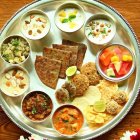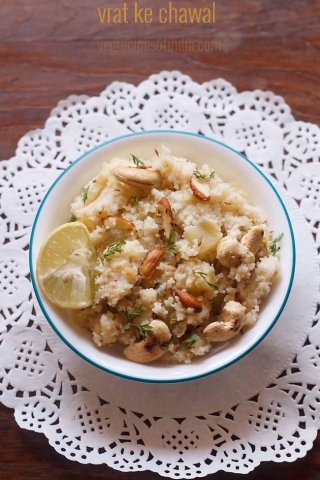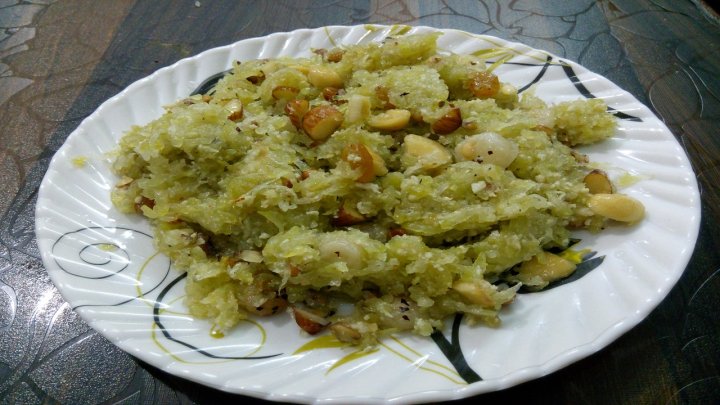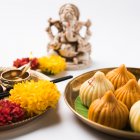-
 Planning to Fast During Navratri? Here are 9 Quick and Healthy Recipes for Your Navratri Fast in 2019!
Planning to Fast During Navratri? Here are 9 Quick and Healthy Recipes for Your Navratri Fast in 2019!
-
 क्या आप नवरात्रि के लिए उपवास कर रहे हैं? यहां आपके लिए 9 नवरात्रि व्यंजन बनाने की विधि है जो आपके लिए शुद्ध, स्वादिष्ट और स्वस्थ की गारंटी है (2020)
क्या आप नवरात्रि के लिए उपवास कर रहे हैं? यहां आपके लिए 9 नवरात्रि व्यंजन बनाने की विधि है जो आपके लिए शुद्ध, स्वादिष्ट और स्वस्थ की गारंटी है (2020)
-
 10 Easy to Make Navratri Fasting Recipes to Keep Your Strength Up for other Festivities + Why Eating Right is So Important at This Time (2019)
10 Easy to Make Navratri Fasting Recipes to Keep Your Strength Up for other Festivities + Why Eating Right is So Important at This Time (2019)
Sharad Navratri or Durga Puja

Navratri (Sanskrit: “nine nights”) or Sharad Navratri or Durga Puja is one of the major festivals celebrated in India in the month of Ashvin. It happens over 9 days and ends with Dussehra or Vijayadashmi on the 10th day. Dussehra or Vijayadashmi is when Maa Durga defeated Mahishasura, the demon. Hence the festival signifies the victory of good over evil. Certain parts of the country also celebrate the festival to honour the victory of Lord Rama over the demon, Ravana. During Navratri, devotees of Goddess Durga worship her nine avatars. They observe fast and perform certain rituals celebrating one avatar each day for the nine days.
Why 9 Days?

Navratri is celebrated on all nine days with such enthusiasm and zeal which is much more than any other festival. The devotees celebrate Goddess Durga in all her incarnations. They also wear different colours each day to honour the Goddess.
- Day 1: Navratri starts with celebrating Shailaputri, a manifestation of Goddess Durga with the combined power of Vishnu, Brahma and Mahesh. Shailaputri is the reincarnation of Goddess Parvati and is the consort of Lord Shiva. She symbolises purity and nature; The colour worn on this day is red.
- Day 2: The second-day honours Brahmacharini. She is blissful and endows happiness, grace, peace and prosperity. Brahmacharini is the one to be worshipped to attain moksha. She is an embodiment of subtle power and hence the colour worn should be royal blue.
- Day 3: Day 3 brings attention to Chandraghanta, the epitome of beauty and bravery. She personifies beauty, tranquillity and grace. The colour of this day is yellow.
- Day 4: Kushmunda, the creative power behind the universe is celebrated on this day. It is said that she created the world with laughter. She is the one who blessed the world with nature, greenery and vegetation. And for this reason, the colour of this day is green.
- Day 5: This day honours and celebrated Skanda Mata, mother of Skanda or Karthikeya. Karthikeya was the one chosen by the Gods as their commander-in-chief when battling the demons. She represents a mother who would fight anyone to protect her child. She is symbolised by the colour grey.
- Day 6: Katyayani is honoured on this day. She was born to the great sage, Kata. She is said to be an avatar of Durga and was brave and courageous. Therefore, the colour of the day is orange.
- Day 7: Day 7 celebrates Durga Maa in her Kalratri avatar. She is the most menacing of all her avatars. Dressed in white, Kalratri is dark in complexion with dishevelled hair and the fiercest expression. Yet the colour of this day is white which represents peace and prayer.
- Day 8: Maha Gauri, an incarnation of Goddess Durga is celebrated on the eighth day. She represents intelligence, calmness and peace. She turned black when being in the Himalayas. However, Lord Shiva had her cleansed with the water of the River Ganges and she got back her beauty and glow. The colour of the day is pink denoting optimism.
- Day 9: The final day of Navratri celebrates Siddhidatri, a representative of a mother figure. She is said to have blessed all the Gods, Goddesses and the devotees with bliss and ecstasy. Consequently, the colour of the day is blue.
9 Navratri Fast Recipes for Delicious and Healthy Dishes

Navratri, the festival that happens over nine days is accompanied by a fast. During this period, devotees abstain from consuming certain foods including meat, fish, onion, ginger and garlic. Some also abstain from rice and include millet in their diet.
Even with all these restrictions, vrat (fasting) food can be delicious and appeal to your taste buds. Don’t believe us? Check out the nine recipes we have for each of the nine days of the fast.
Sabudana Vrat Dosa

If you are skipping rice during the vrat period, Sabudana Vrat Dosa would be your lifeline. Being a gluten-free food and needing no fermentation period, the dosa could be prepared in a pinch.
Sabudana Vrat Dosa
Ingredients:For Batter:
- Sabudana - ½ cup
- Barnyard Millet/Sama Rice - 1 cup
- Kuttu Flour - 1½ tbsp
- Buttermilk - ¼ cup
- Salt - To taste
- Oil - 2 tbsp
- Potatoes - 3 Medium
- Turmeric - ¼ tsp
- Red Chilli Powder - ¼ tsp
- Mustard Seeds - ¼ tsp
- Curry Leaves - 1 Sprig
- Oil - 1 tbsp
- Salt - To Taste
How to Make:
Batter:
- Wash sabudana and barnyard millet under running water till they run clean. Soak them separately for about 3-4 hours.
- After 4 hours, drain them and wash again.
- Transfer to a blender and grind them until they are a smooth puree.
- Add kuttu flour, salt and buttermilk; mix until they are well incorporated.
- Make sure the batter has no lumps and is of a batter consistency.
- Boil, peel and cube the potatoes.
- Heat oil in a pan. Once hot, add mustard seeds.
- When it sputters, add turmeric, red chilli powder, salt and curry leaves; Stir well.
- Add potatoes and mix in with the spices. Allow it to cool.
- Heat the dosa pan and grease it with oil.
- Pour a ladle of the batter and spread evenly. Drizzle a few drops of oil around the edges. Cover and cook on low flame.
- The starch in sabudana makes for a sticky dosa. So be careful when rolling.
- Place the potato filling the centre and roll the dosa on both the edges.
- Serve hot with chutney.
Rajgira Puri Recipe

Rajgira Puri is different from the traditional puri in the sense that it uses rajgira flour, which is gluten-free. Hence it needs a starch like potatoes as a binding agent. This gives a grainy texture to the puri while being soft.
Rajgira Puri
Ingredients:- Rajgira/Amaranth Flour - 2 cups
- Potato - 1
- Black Pepper Powder - 1/2 tsp
- Salt - To taste
- Oil - To fry
How to Make:
- Boil and mash the potato.
- Mix all the ingredients in a bowl and knead it into a dough.
- Make small balls of the dough. Dust them with rajgira flour and flatten it with a pin. It should be thick and small enough to fry.
- Heat oil in a kadai. Once hot, add the flattened puri. Using a slotted spoon, press the puri gently to help it rise up.
- Once its risen, turn it over and fry until golden.
- Continue for all the flattened puris.
- Serve hot with your favourite sabzi or curry.
Spicy Millet Salad Bowl

Who says vrat food cannot feed the fitness freak in you? We have this awesome Buddha Bowl filled with all sorts of deliciousness and every inch healthy. For the grains, we have chosen vrat friendly sama rice; paneer for proteins; avocados for fats; some more veggies and fruits; And finally some yummy fried sabudana balls.
Spicy Millet Salad Bowl
Ingredients:For Sama Rice:
- Sama Rice/Barnyard Millet - 1 cup
- Water - 1¼ cup
- Salt - To taste
- Sabudana - 1 cup soaked
- Amchur Powder - 1 tsp
- Peanut Powder - 2 tbsp
- Red Chilli Powder - ½ tsp
- Turmeric Powder - ½ tsp
- Kuttu Flour - 3 tbsp
- Potatoes - 2 medium (boiled and peeled)
- Cilantro Leaves - ½ tsp (chopped)
- Salt - To taste
- Oil - To cook
- Avocado - 1 medium
- Cucumber - 1 small
- Grilled Paneer - ¾ cup
- Pomegranate Seeds - 3 tbsp
- Green Chutney - 1 cup
How to Make:
Sama Rice:
- Measure and add the sama rice and water to a pan. Bring it to a boil.
- Reduce the heat to low; cover and cook for another 15 minutes.
- Cool it; once cold, fluff it with a fork.
- Add all the ingredients to a bowl and mix well. The resultant mixture should be moist.
- Shape them into balls. Deep fry them, if you do not have an appe pan.
- If you have an appe pan, cook the balls with a little oil in appe pan.
- Cube and grill the paneer in a griddle or pan.
- Assemble the grilled paneer, sama rice, avocado, cucumber, pomegranate and sabudana balls.
- Add the dressing i.e. green chutney of your choice.
Banana Walnut Lassi

Lassi is something that Indians cannot do without especially during summers. But did you know that it can be consumed during Navratri too? Adding a twist to the traditional lassi, we have the Banana Walnut Lassi for you.
Banana Walnut Lassi
Ingredients:- Low Fat Yogurt - 1 cup
- Banana - ½
- Walnuts - 3 + 1 (for garnish)
- Honey - 2 tsp (as per taste)
- Seeds - 1 tsp (mix of flax and sesame seeds)
How to Make:
- Add all the ingredients to a food processor and blend until smooth and creamy.
- Transfer to a mason jar and garnish with chopped walnuts.
- You can substitute walnuts with Brazil nuts, hazelnuts or pine nuts.
Samvat Pulao

Since rice is usually not preferred during fasting, sama rice or barnyard millet comes into play. It is a member of the millet family and can be quite healthy. It can be substituted for rice in any rice-based dish.
Samvat Pulao
Ingredients:- Barnyard Millet - 1 cup
- Cumin Seeds - 1 tsp
- Cinnamon Stick - ½ inch
- Cloves - 3
- Green Cardamom - 2
- Black Pepper - 4
- Ginger - 1/2 inch
- Green Chili - 1
- Curry Leaves - 1 sprig
- Coriander Leaves - 1 tbsp (chopped) + 1 tbsp (chopped for garnish)
- Peanuts - 1 tbsp
- Potatoes - 2 medium (peeled and cubed)
- Cashews - 10
- Almonds - 10
- Water - 3 cups
- Lemon Juice - As needed
- Lemon Wedges - As needed
- Salt - To taste
- Oil - 2 tbsp
How to Make:
- Rinse and wash the barnyard millet and soak for 30 minutes.
- Dry roast peanuts till they become crunchy. Grind them coarsely in a dry grinder.
- Crush ginger and green chilli in a mortar and pestle.
- Heat oil in a kadai. Add cumin, cinnamon, cardamom, cloves and pepper.
- Once cumin sputters and the spices fragrant, add the crushed ginger and chilli mixture. Saute for about 3 minutes.
- Add the curry leaves, coriander leaves and the cubed potatoes. Saute for 4 more minutes.
- Add the peanuts powder and the drained sama rice/barnyard millet.
- Stir them for a bit and add the water.
- Bring it to boil and pressure cook for 4 whistles.
- Dry roast the cashews and almonds.
- Once the pulao is cooked, garnish with nuts and coriander leaves.
- Serve with a drizzle of lemon juice and a lemon wedge on the side.
Spinach Potato Cutlet

Vrat or not, your snack hunger always sneaks up on you. Cutlets are a common snack in India. Though meat is a primary ingredient, vegetarian cutlets are also very popular. This vrat friendly snack is easy to make and the addition of spinach makes it nutritious too.
Spinach Potato Cutlet
Ingredients:For Cutlet:
- Palak/Spinach - 1 bunch (chopped)
- Potato - 3 (boiled and mashed)
- Paneer - ½ cup (grated)
- Oil - 3 tsp
- Chilli - 3
- Ginger - 1 inch (crushed)
- Coriander Powder - 1 tsp
- Cumin Powder - ¼ tsp
- Garam Masala - ½ tsp
- Amchur Powder - ½ tsp
- Bread Crumbs - ½ cup
- Coriander - 2 tbsp (finely chopped)
- Salt - To taste
- Corn Flour - 2 tbsp
- Maida - 1 tbsp
- Chilli Flakes - ¼ tsp
- Salt - ¼ tsp
- Water - ½ cup
- Bread Crumbs - 1 cup
- Oil - As needed
How to Make:
Cutlet Prep:
- Heat a kadai and add 3 tsp oil. Once hot, add chilli, ginger and saute.
- Add the palak and saute until it shrinks. When cold, blend it smooth without adding water.
- To the paste, add potatoes, paneer, bread crumbs, coriander powder, cumin powder, garam masala, amchur, coriander and salt.
- Combine the ingredients well, until it’s all well incorporated. If the dough is sticky add more bread crumbs and mix well.
- Mix cornflour, maida, chilli flakes and salt to water one by one; make sure there are no lumps and the maida paste is smooth and creamy.
- Take a small ball sized cutlet prep and further shape it into a cylinder.
- Dip the cutlet in the maida paste and then in the bread crumbs.
- Do the above step again for an even and good coating.
- Deep fry in hot oil until its golden brown. Health nuts can also bake it in a preheated oven at 180°C for 15 minutes.
Roasted Lotus Seed

Roasted Phool Makhana/Lotus Seeds are a healthy snack you can include in your daily diet. They are rich in protein, calcium and minerals. The crunchy snack makes for an ideal vrat food as well.
Roasted Lotus Seeds
Ingredients:- Phool Makhana/Lotus Seeds - 1 cup
- Salt - To taste
- Pepper - To taste
- Turmeric Powder - 1 pinch
- Ghee - 1 tsp
How to Make:
- Melt the ghee and add the spices including salt.
- Dry roast the lotus seeds in a heavy-bottomed pan on medium-low heat. The roasting takes place slowly and should be done in about 10 minutes.
- Add the ghee mix and roast for 2 more minutes. If roasted properly, the makhana should be crunchy.
- Once done, cool completely and store in an airtight container.
Barfi

Bring your sweet tooth to Navratri fast as well!!! Coz’ we have some amazing recipes to satisfy your cravings. One that tops the list is the Vrat Barfi made of amaranth flour.
Barfi
Ingredients:- Amaranth (Rajgira) Flour – ½ cup
- Water Chestnut (Shingada) Flour – ½ cup
- Cardamom Powder – ½ tsp
- Sesame Seeds – 1 tsp
- Ghee – 3 tbsp
- Jaggery - 1/2 cup or as per taste
How to Make:
- Add ghee to amaranth flour and dry roast on medium heat.
- Dry roast water chestnut flour and mix with amaranth flour.
- In a pan, melt 1 tsp ghee and add jaggery to it. Melt the mixture in low flame.
- Once the jaggery is melted, add the flour mixture, sesame seeds and cardamom powder; mix well.
- Pour the mixture in a wide dish and let it cool. Once it reaches room temperature, cut the barfi to pieces ready for serving.
Bottle Gourd Pudding

Lauki Ka Halwa or Bottle Gourd Pudding is quite a famous dish all over India. Since the ingredients are vrat friendly, the dish is made throughout Navratri.
Bottle Gourd Pudding
Ingredients:- Ghee - 3 tbsp
- Lauki/Bottle Gourd - 1 medium
- Pistachio - 1 tbsp (thinly sliced)
- Almonds - 8 (thinly sliced)
- Cashew Nuts - 8 (thinly sliced)
- Sugar - ⅓ cup
- Khoya/Thickened Milk - ⅓ cup
- Green Cardamoms - 3
How to Make:
- Wash, peel and remove the seeds of the lauki. Grate the flesh in a bowl.
- Grind the seeds of cardamom in a mortar and pestle.
- Add ghee to a hot kadai. Once hot, add the grated lauki and saute for about 15 minutes on medium heat until it is cooked.
- Then add the sliced nuts and sugar. Mix well and cook until all the water evaporates.
- Add grated khoya and cook for about a minute.
- Add powdered cardamom powder and serve it hot.
Do’s and Don'ts of Navratri Fast

Ardent devotees of Maa Durga observe a strict fast and follow many associated rituals. These rituals and fasts differ from region to region. But certain things should be avoided at all costs. We have put together a list for you. But do check with the elders in the family regarding the customs and traditions to be followed.
- Avoid Haircut or Clipping Your Nails: Followers of Maa Durga who observe the fast should avoid cutting their hair, clipping their nails and even shaving during this period. It is said that doing any of these invokes the wrath of the goddess.
- No Afternoon Nap: According to Vishnu Purana, devotees following the fast should abstain from having their afternoon nap. If you sleep in the daytime you lose all the good karma obtained from the fast.
- No Alcohol Consumption: It is better to avoid alcohol consumption during this period as with all Hindu festivals. It is considered quite inauspicious.
- Keep an Eye on the Akhand Jyoti: If you are lighting the Akhand Jyoti, make sure the diya is lit all the time. Keep an eye on the diya; Also, the house should never be vacant and someone should be at home at all times.
- Fast does not Mean Starvation: Those observing a fast during Navratri should remember to have regular meals consisting of healthy vrat-friendly food. Vrat-friendly foods are satvik and are easy on the stomach and help you to detoxify your body.
-
 Want to Pamper Your Taste-Buds this Pongal? Here are Mouth-Watering Pongal Recipes You can't Miss in 2019
Want to Pamper Your Taste-Buds this Pongal? Here are Mouth-Watering Pongal Recipes You can't Miss in 2019
-
 Learn Some Popular Indian Food Recipes: 11 Dishes That Prove Just How Simple It Can Be to Cook in Your Kitchen Versus Relying on Takeout (2019)
Learn Some Popular Indian Food Recipes: 11 Dishes That Prove Just How Simple It Can Be to Cook in Your Kitchen Versus Relying on Takeout (2019)
-
 भारतीयों का मिठाई के लिए एक विशेष झुकाव है: 10 सबसे स्वादिष्ट भारतीय मिठाइयाँ विकल्प जिन्हे देख कर आपके मुंह में पानी आ जायेगा (2019)
भारतीयों का मिठाई के लिए एक विशेष झुकाव है: 10 सबसे स्वादिष्ट भारतीय मिठाइयाँ विकल्प जिन्हे देख कर आपके मुंह में पानी आ जायेगा (2019)
-
 Making Cakes Need Not Be Complicated! Learn How to Make Cake from Biscuits. 10 Recipes for Super Easy, Cheap and Yummy Cakes!
Making Cakes Need Not Be Complicated! Learn How to Make Cake from Biscuits. 10 Recipes for Super Easy, Cheap and Yummy Cakes!
-
 क्या आप नवरात्रि के लिए उपवास कर रहे हैं? यहां आपके लिए 9 नवरात्रि व्यंजन बनाने की विधि है जो आपके लिए शुद्ध, स्वादिष्ट और स्वस्थ की गारंटी है (2020)
क्या आप नवरात्रि के लिए उपवास कर रहे हैं? यहां आपके लिए 9 नवरात्रि व्यंजन बनाने की विधि है जो आपके लिए शुद्ध, स्वादिष्ट और स्वस्थ की गारंटी है (2020)
Make Your Navratri Special with Delicious Navratri Recipes
We hope this BP Guide would have helped you in appreciating the various recipes which you can prepare during Navratri keeping our customs and traditions in mind. These will not only help you to delight your guests but will also help your family to have healthy food which will detoxify the body.








 Highlight the Best Facets of Your Incomparable Beauty: Discover the Best Face Highlighter Currently Available in India and Everything You Need to Know About Using Face Highlighters for Maximum Effect (2023)
Highlight the Best Facets of Your Incomparable Beauty: Discover the Best Face Highlighter Currently Available in India and Everything You Need to Know About Using Face Highlighters for Maximum Effect (2023)
 Forget the Blemishes and Get that Picture Perfect Flawless Radiance on Your Face: Check out the Best Foundations for Oily Skin Currently Available in India and Everything You Need to Know About Makeup Foundations (2023)
Forget the Blemishes and Get that Picture Perfect Flawless Radiance on Your Face: Check out the Best Foundations for Oily Skin Currently Available in India and Everything You Need to Know About Makeup Foundations (2023)
 Make Your Presence Felt Wherever You Go: Discover the Best Perfumes Under 2000 for Both Men and Women to Announce Your Arrival and Make Any Occasion Memorable (2023)
Make Your Presence Felt Wherever You Go: Discover the Best Perfumes Under 2000 for Both Men and Women to Announce Your Arrival and Make Any Occasion Memorable (2023)
 Protect Your Oily Skin from the Harmful Rays of the Sun: Discover the Best Gel Based Sunscreens for Oily Skin and Everything You Need to Know Before Buying One (2023)
Protect Your Oily Skin from the Harmful Rays of the Sun: Discover the Best Gel Based Sunscreens for Oily Skin and Everything You Need to Know Before Buying One (2023)
 Minor Blemishes and Wrinkles Affecting Your Confidence? Check out the Best BB Creams to Conceal Your Worries and Nourish Your Skin to Restore the Healthy, Radiant and Glowing Complexion Back Again (2023)
Minor Blemishes and Wrinkles Affecting Your Confidence? Check out the Best BB Creams to Conceal Your Worries and Nourish Your Skin to Restore the Healthy, Radiant and Glowing Complexion Back Again (2023)
